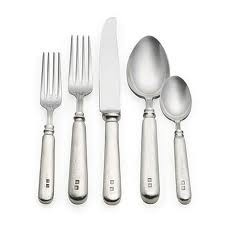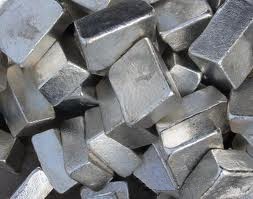Pewter
Melting
Point:
338-446
Fahrenheit
\ 170-230
Celsius
Boiling Points of Alloys:
Tin - 4716 Fahrenheit \ 2602 Celsius
Lead - 3180 Fahrenheit \ 1749 Celsius
Copper - 4643 Fahrenheit \ 2562 Celsius
Antimony - 2889 Fahrenheit \ 1587 Celsius
Bismuth - 2847 Fahrenheit \ 1564 Celsius
Relatively soft and ductile metal with a silvery white color glowing beauty and practical function.
Malleable Metal Alloy
Lead Pewter Alloy 85–99% tin, with the remainder consisting of copper, antimony, bismuth and lead.
Lead-Free Pewter Alloy: An alternative to lead, the low copper content of this alloy pours more easily at the casting temperature than standard pewter. Todays newly manufactured pewter should be a lead free alloy usually being hardened with additions of antimony and copper, containing over 90% tin. Other elements such as silver and bismuth are sometimes used.
The Main Constituents of Modern Lead Free Pewter is Tin: (Sn), usually between 90 and 98%. Pure tin is soft which is why it needs to be mixed with other metals such as Antimony and Copper.
Antimony: (Sb), (a toxic chemical element). Antimony improves the casting qualities and has a considerable hardening effect. Modern pewter's generally contain between 0.5 and 8 %.
Copper: (Cu), Like antimony copper improves the casting qualities has a slight hardening effect and helps retain the antimony in the molten pewter, often present between 0.25 and 2.5%.
Pewter is made by melting the tin in a cast iron melting pot, the calculated weight (percentages are by weight) of copper is added to the molten tin, being heavier it sinks into the melt. Copper dissolves in molten tin at relatively low temperatures once dissolved the antimony is added again this dissolves easily without the melt going much above 752F/400C. After cooling and thorough stirring the metal is poured into ingot moulds. Sheet pewter is made by casting billets which are scalped off then progressively reduced in thickness by passing through rollers.
Pewter (soft) an alloy is mostly Tin which in itself is a precious and expensive metal with a small amount of copper (and other ingredients for additional strength). Opposite would be bronze (hard), an alloy made up primarily of copper, with a small amount of tin.
Pewter one of the first foundry metals going back thousands of years around the Bronze Age is famous for the easily made useful items like plates, Cutlery / flatware, containers, mugs, vases and decretive items, jewelry, candlesticks, etc.
The first type, known as "fine metal", was used for flatware. It consisted of tin with as much copper as it could absorb, which is about 1%.
The second type, known as "trifling metal" or "trifle", was used for hollowware. It is made up of fine metal with approximately 4% lead.
The last type of pewter, known as "lay" or "ley" metal, was used for items that were not in contact with food or drink. It consisted of tin with 15% lead. These three alloys were used, with little variation, until the 20th century
The demand for pewter today is growing at a rapid rate for both its beauty and workability that craftsman enjoy to make very desirable items with. Pewter's with higher lead content are heavier, tarnish faster, and oxidation gives them a darker silver-gray color for a unique aged look many find in a class of its own. Other lead free Pewter items share an equal to greater appeal for safety and clean rich look.
All and all, pewter is a very desirable foundry casting metal and a metal smiths favorite with low melting points and ease of malleability to for casting, forming, shaping and decorating. It has found its place in homes, jewelry, awards, medals and much more. Pewter is an excellent and easy material to recycle from un-needed, worn, or broken Pewter items. It is also readily available in ingot form from suppliers.
About Metal Spot Prices: The spot price of metals is based on paper contracts for delivery of tons of pure metal ingots. When you're not prepared to pay for and take delivery of tons of metal ingots, that spot price will quickly become a huge understatement of the real price of that metal. When you want to buy just a few pounds of Pewter for example, you're looking at substantially higher prices. Moreover, once you own physical Pewter ingots, make absolutely sure you never sell for the spot price of Pewter. Because it's hard to get ingot grade Pewter in physical form, you've got something special on your hands and make sure to extract the full value when you're selling and understand the reverse when buying.

Melting and casting Pewter into clean ingots for sale can be a profitable business just by itself as a highly sought after metal for others to work with. It all starts with raw materials and Pewter ingots are currently selling in the Twenty dollar range per pound and rising.
TheFoundryZone.com
Boiling Points of Alloys:
Tin - 4716 Fahrenheit \ 2602 Celsius
Lead - 3180 Fahrenheit \ 1749 Celsius
Copper - 4643 Fahrenheit \ 2562 Celsius
Antimony - 2889 Fahrenheit \ 1587 Celsius
Bismuth - 2847 Fahrenheit \ 1564 Celsius
Relatively soft and ductile metal with a silvery white color glowing beauty and practical function.
Malleable Metal Alloy

Lead Pewter Alloy 85–99% tin, with the remainder consisting of copper, antimony, bismuth and lead.
Lead-Free Pewter Alloy: An alternative to lead, the low copper content of this alloy pours more easily at the casting temperature than standard pewter. Todays newly manufactured pewter should be a lead free alloy usually being hardened with additions of antimony and copper, containing over 90% tin. Other elements such as silver and bismuth are sometimes used.
The Main Constituents of Modern Lead Free Pewter is Tin: (Sn), usually between 90 and 98%. Pure tin is soft which is why it needs to be mixed with other metals such as Antimony and Copper.
Antimony: (Sb), (a toxic chemical element). Antimony improves the casting qualities and has a considerable hardening effect. Modern pewter's generally contain between 0.5 and 8 %.
Copper: (Cu), Like antimony copper improves the casting qualities has a slight hardening effect and helps retain the antimony in the molten pewter, often present between 0.25 and 2.5%.
Pewter is made by melting the tin in a cast iron melting pot, the calculated weight (percentages are by weight) of copper is added to the molten tin, being heavier it sinks into the melt. Copper dissolves in molten tin at relatively low temperatures once dissolved the antimony is added again this dissolves easily without the melt going much above 752F/400C. After cooling and thorough stirring the metal is poured into ingot moulds. Sheet pewter is made by casting billets which are scalped off then progressively reduced in thickness by passing through rollers.
Pewter (soft) an alloy is mostly Tin which in itself is a precious and expensive metal with a small amount of copper (and other ingredients for additional strength). Opposite would be bronze (hard), an alloy made up primarily of copper, with a small amount of tin.
Pewter one of the first foundry metals going back thousands of years around the Bronze Age is famous for the easily made useful items like plates, Cutlery / flatware, containers, mugs, vases and decretive items, jewelry, candlesticks, etc.
The first type, known as "fine metal", was used for flatware. It consisted of tin with as much copper as it could absorb, which is about 1%.
The second type, known as "trifling metal" or "trifle", was used for hollowware. It is made up of fine metal with approximately 4% lead.
The last type of pewter, known as "lay" or "ley" metal, was used for items that were not in contact with food or drink. It consisted of tin with 15% lead. These three alloys were used, with little variation, until the 20th century
The demand for pewter today is growing at a rapid rate for both its beauty and workability that craftsman enjoy to make very desirable items with. Pewter's with higher lead content are heavier, tarnish faster, and oxidation gives them a darker silver-gray color for a unique aged look many find in a class of its own. Other lead free Pewter items share an equal to greater appeal for safety and clean rich look.
All and all, pewter is a very desirable foundry casting metal and a metal smiths favorite with low melting points and ease of malleability to for casting, forming, shaping and decorating. It has found its place in homes, jewelry, awards, medals and much more. Pewter is an excellent and easy material to recycle from un-needed, worn, or broken Pewter items. It is also readily available in ingot form from suppliers.
About Metal Spot Prices: The spot price of metals is based on paper contracts for delivery of tons of pure metal ingots. When you're not prepared to pay for and take delivery of tons of metal ingots, that spot price will quickly become a huge understatement of the real price of that metal. When you want to buy just a few pounds of Pewter for example, you're looking at substantially higher prices. Moreover, once you own physical Pewter ingots, make absolutely sure you never sell for the spot price of Pewter. Because it's hard to get ingot grade Pewter in physical form, you've got something special on your hands and make sure to extract the full value when you're selling and understand the reverse when buying.

Melting and casting Pewter into clean ingots for sale can be a profitable business just by itself as a highly sought after metal for others to work with. It all starts with raw materials and Pewter ingots are currently selling in the Twenty dollar range per pound and rising.
TheFoundryZone.com